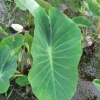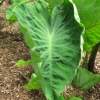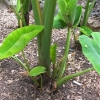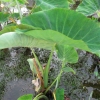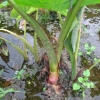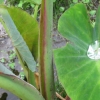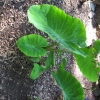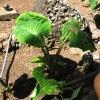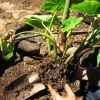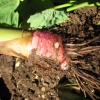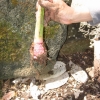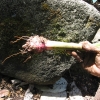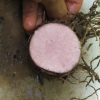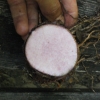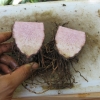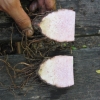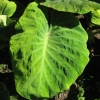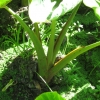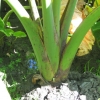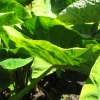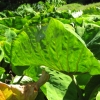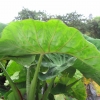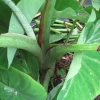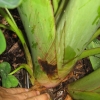Use As Food
Makes a red poi that is highly prized for flavor and quality.
Distribution
Essentially a lo‘i (wetland) taro although grown to some extent under upland, dryland culture (māla) in Kona, where it goes under the name Moiula. This variety is one of the most important of the lo‘i (wetland) poi taros, and is planted extensively on the windward side of O‘ahu.
General Characteristics
Short, erect, stocky, maturing within 8 to 12 months, producing from 2 to 5 ‘ohā; easily distinguished by broad, crinkly blades and short, stocky, dark green Hā (Petiole) tinged with pink.
Ha (Petiole)
45 to 65 cm. long, fairly thick and rigid, dark green with pinkish tinge and conspicuous narrow red lihi (edge), a reddish-purple ring at kōhina (base) with lilac-pink for 3 to 4 cm, above the base.
Lau or Lu'au(Leaf Blade)
45 to 55 cm. long, 30 to 35 cm. wide, 40 to 45 cm. from tip to base of sinus (māwae), horizontal, egg-shaped (ovate), slightly cupped, crinkled, dark green with light pinkish cast on lower surface; piko small, light pinkish to greenish marginal veins often tinged with red; round leaf section (lobes) wide (obtuse) with shallow, wide lihi māwae (sinus).
'I'o kalo (Corm)
Flesh lilac-purple with darker purple fibers; skin brilliant reddish-purple.
Pua (Flower)
Hā (peduncle) yellowish-green; flower cover (spathe) 26 to 33 cm. long, the lower tubular portion usually 4.5 to 6 cm. or sometimes as much as 9 cm. long, yellowish.green, often tinged with red, the upper portion yellow, usually rather open or loosely rolled; spadix (spike of flower) 9 to 12 cm, long, the sterile appendage (tip of flower's spike) 1.2 to 2 cm. long.
Remarks
This is one of the oldest varieties grown in the islands, known in the early days of Hawaiian history as one of the royal taros. It was considered particularly desirable as an offering to the gods. The Chinese generally harvest this taro at 12 to 14 months, the Hawaiian growers at 8 to 10 months when the quality is considered better although the total yield is not so great.

